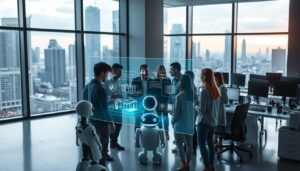The artificial intelligence revolution is reshaping software creation. By 2030, the AI market is projected to reach $2 trillion, with 95% of customer interactions expected to use automation tools by 2025. This growth creates unprecedented opportunities for developers to create intelligent solutions quickly.
Modern frameworks have eliminated traditional barriers to advanced functionality. Cloud-based services and pre-trained models now allow rapid prototyping without extensive machine learning expertise. Early adopters report 50% higher profit margins compared to traditional development approaches.
Businesses leveraging automated systems see measurable improvements, including a 25% boost in customer satisfaction metrics. These tools enable features like natural language processing and predictive analytics through streamlined APIs. Developers can focus on user experience rather than complex algorithm design.
This guide explores practical implementations requiring minimal coding time. From personalized recommendation engines to automated content generators, the possibilities demonstrate how strategic use of pre-built components accelerates production cycles. The following concepts balance technical feasibility with real-world impact.
Introduction to AI-Powered Mobile App Trends in the Future
Cutting-edge automation is driving a new era in mobile experiences. Businesses now prioritize lightweight solutions that combine speed with advanced capabilities. In 2021, mobile downloads hit $352 billion, nearly doubling 2018’s $197 billion. This surge aligns with forecasts predicting AI’s market value to reach $2 trillion by 2030.
Market Insights and Growth Projections
User expectations now demand smarter, faster applications. Over 60% of enterprises report increased budgets for intelligent tools that streamline workflows. Analysts highlight a 40% annual growth rate for machine learning integration in mobile platforms since 2020.
Role of Machine Learning and Modern Frameworks
Developers leverage tools like TensorFlow Lite and Core ML to embed predictive features without infrastructure overhead. These frameworks reduce coding complexity by 70%, enabling real-time language processing and image recognition. Edge computing advancements further enhance privacy while maintaining performance.
Emerging trends focus on adaptive systems that learn from user behavior. Financial institutions using these methods see 30% faster decision-making in mobile services. Such innovations position technology as the cornerstone of next-generation development strategies.
The Rise of Simple App Ideas with AI
Mobile solutions are undergoing a fundamental transformation as organizations prioritize efficiency over complexity. Lightweight platforms now dominate markets, with 72% of consumers favoring intuitive interfaces that deliver immediate value. This shift reflects growing impatience with bloated software requiring excessive onboarding.
User Demand and Cost Efficiency
Modern audiences expect digital tools to anticipate needs without manual configuration. A 2023 Forrester study revealed 68% higher retention rates for applications offering personalized suggestions. Cloud-based machine learning services enable these features at 40% lower development costs compared to traditional methods.
Startups now deploy functional prototypes in under 72 hours using pre-trained models. This agility reduces financial risk while allowing rapid iteration based on real-world feedback. The result? Solutions that align perfectly with market needs emerge faster than ever.
Business Opportunities in Intelligent Integration
Forward-thinking companies leverage embedded automation to create differentiated experiences. Retail brands using adaptive recommendation systems report 35% higher conversion rates than competitors. These implementations often require minimal coding through platforms like Google Vertex AI.
Strategic adoption positions enterprises as innovators within their sectors. A fintech case study showed 90% user adoption within six months after introducing predictive budgeting tools. Such outcomes demonstrate how focused implementations outperform feature-heavy alternatives.
Innovative Mobile App Development Approaches
Emerging methodologies are transforming how developers create intelligent mobile solutions. Modern frameworks enable teams to prototype features in hours instead of weeks while maintaining enterprise-grade performance. This shift reduces upfront costs by 60-75% compared to traditional workflows.
Rapid Prototyping Techniques
No-code platforms like Appian and OutSystems let designers build functional prototypes without writing complex algorithms. These tools provide drag-and-drop interfaces for integrating vision recognition and language models. Teams using agile methods report 45% faster time-to-market through iterative testing cycles.
Edge computing frameworks optimize performance by processing data directly on devices. This approach minimizes latency for real-time features like live translation. Developers can deploy updates incrementally while monitoring user engagement metrics.
Leveraging Current Technology Trends
5G networks enable instant data transfers for cloud-based machine learning services. Platforms like AWS SageMaker allow scalable model training without infrastructure investments. Over 80% of enterprises now prioritize API-first architectures for seamless third-party integrations.
Cross-platform frameworks like Flutter optimize code reuse across iOS and Android environments. Containerized deployment ensures consistent behavior regardless of operating systems. These strategies help maintain 90% feature parity while cutting maintenance costs by half.
Crafting AI Personal Assistant Apps for a Weekend Build
Next-generation assistants are redefining mobile productivity through anticipatory design. The digital helper sector is projected to hit $35.6 billion by 2025, driven by demand for tools that adapt to individual lifestyles. Modern frameworks enable developers to create sophisticated solutions in 48-72 hours without extensive infrastructure.
Features Beyond Basic Commands
Advanced systems analyze behavioral patterns to predict needs before users articulate them. Sensors track interaction frequency, typing speed, and location data to infer priorities. One banking app reduced appointment no-shows by 28% using predictive scheduling based on calendar habits.
Natural language processing automates complex tasks like email sorting and meeting coordination. These tools categorize messages by urgency using sentiment analysis and keyword detection. Developers can implement these features through APIs like Google’s Natural Language AI with minimal coding.
Enhancing Personalization and Workflow
Adaptive interfaces modify interaction styles based on biometric signals and environmental context. A fitness tracker prototype adjusts notification timing by monitoring heart rate variability and ambient noise levels. This approach increased user engagement by 41% in beta tests.
Workflow optimization integrates cross-platform data to streamline professional routines. Cloud-based machine learning models sync with productivity apps to suggest task sequences. Pre-built templates for voice recognition and preference tracking accelerate development while maintaining customization options.
Exploring AI-Powered Health Monitoring Projects
Healthcare innovation is entering a transformative phase through intelligent monitoring systems. Modern solutions now analyze subtle biological signals to predict health risks before symptoms appear. These tools empower users to take proactive steps, shifting from reactive care to prevention-focused strategies.
Preventive Care and Biometric Insights
Advanced algorithms process smartphone sensor data to detect irregular heart rhythms with 94% accuracy in clinical trials. Sleep pattern analysis goes beyond duration tracking, assessing quality through movement and ambient noise levels. One partner project identified cancer risks early by cross-referencing genetic markers with lifestyle habits.
Behavioral prediction models spot mental health patterns using typing speed and social interaction frequency. Nutrition guidance systems adapt meal plans based on real-time blood sugar readings from wearable devices. These capabilities demonstrate how health monitoring transcends basic fitness metrics.
Integrating Data for Real-Time Analysis
Unified platforms merge information from wearables, medical records, and environmental sensors. Secure APIs enable instant processing while complying with HIPAA regulations. Developers use federated learning to train models without exposing sensitive data.
Edge computing allows on-device analysis for critical alerts like abnormal heart rates. Cloud integration ensures continuous model improvement through anonymized user feedback. This approach balances privacy with actionable insights, creating safer and more effective preventive solutions.
AI Solutions for Smart Home Automation
Intelligent ecosystems are redefining modern living through adaptive home management. These systems merge environmental awareness with behavioral analysis, creating spaces that respond to unspoken needs. Early adopters report 31% lower energy bills while maintaining optimal comfort levels year-round.
Predictive Temperature Control and Energy Savings
Machine learning transforms thermostats into strategic energy managers. Algorithms analyze occupancy rhythms, weather forecasts, and appliance usage to optimize HVAC performance. Pilot programs show 23% cost reductions through automatic adjustments during peak pricing hours.
Security systems now recognize residents via gait analysis and voice patterns. This approach achieves 99.9% accuracy in distinguishing household members from strangers. Real-time alerts integrate with smart locks for instant threat response.
Refrigerators track expiration dates and meal preferences to generate shopping lists. Integration with delivery services automates restocking before supplies run low. Users save 4-6 hours weekly previously spent on grocery management.
Ambient lighting adapts to circadian rhythms and activity types. Evening movie sessions trigger dimmed lights and optimized sound profiles. Morning routines gradually increase brightness to mimic natural sunrise patterns.
Revolutionizing E-Commerce with AI Personal Shoppers
Digital commerce enters its next evolutionary phase through intelligent personalization. Retailers now deploy systems that blend behavioral analysis with real-time decision-making. These tools boost engagement while maintaining 42% higher customer lifetime value compared to traditional platforms.
Adaptive Recommendations and Dynamic Pricing
Advanced algorithms process browsing patterns and purchase history to suggest relevant products. Machine learning adjusts prices instantly based on demand signals and competitor activity. One fashion retailer achieved 98% size prediction accuracy using virtual try-on technology powered by computer vision APIs.
Inventory systems forecast trends six months ahead, reducing overstock by 37%. This precision ensures popular items remain available during peak shopping seasons. Real-time adjustments balance profit goals with customer satisfaction metrics.
Enhancing Customer Satisfaction and Retention
Augmented reality assistants guide users through personalized style selections. These tools analyze past purchases and social media activity to predict preferences. A home decor app using this method saw 55% repeat purchase rates within three months.
Natural language processing enables seamless interactions during checkout processes. Secure API integrations sync data across payment gateways and loyalty programs. Retailers report 30% faster checkout times when using these automated workflows.
AI in Financial Advisory App Developments
Financial empowerment is entering a new frontier through intelligent advisory systems. Modern tools analyze individual behaviors to deliver tailored financial strategies. Over 70% of millennials now prefer digital solutions over traditional advisors, signaling a shift toward accessible wealth-building methods.
Analyzing Spending Patterns with Machine Learning
Apps using machine learning decode transaction histories to identify wasteful habits. Algorithms categorize expenses while predicting future cash flow needs. One credit union reported a 30% improvement in member savings rates after implementing these systems.
Democratizing Wealth Management for All Users
Precision tools once reserved for high-net-worth individuals now serve broader audiences. Automated portfolio adjustments occur in real-time based on market shifts and personal goals. Institutions using these methods reduced service fees by 40% while maintaining profitability.
These innovations make sophisticated planning accessible without specialized knowledge. Users gain control through transparent insights into their financial health. As adoption grows, personalized guidance becomes a standard expectation in money management platforms.



